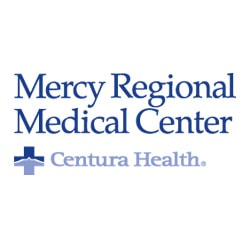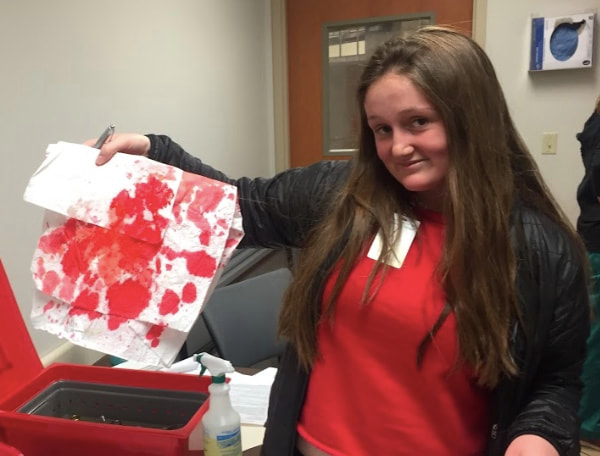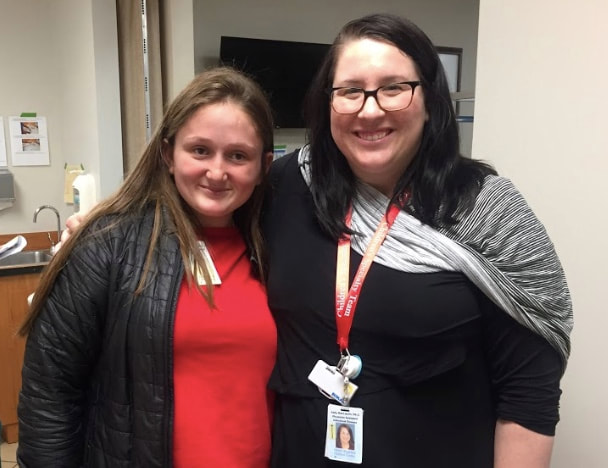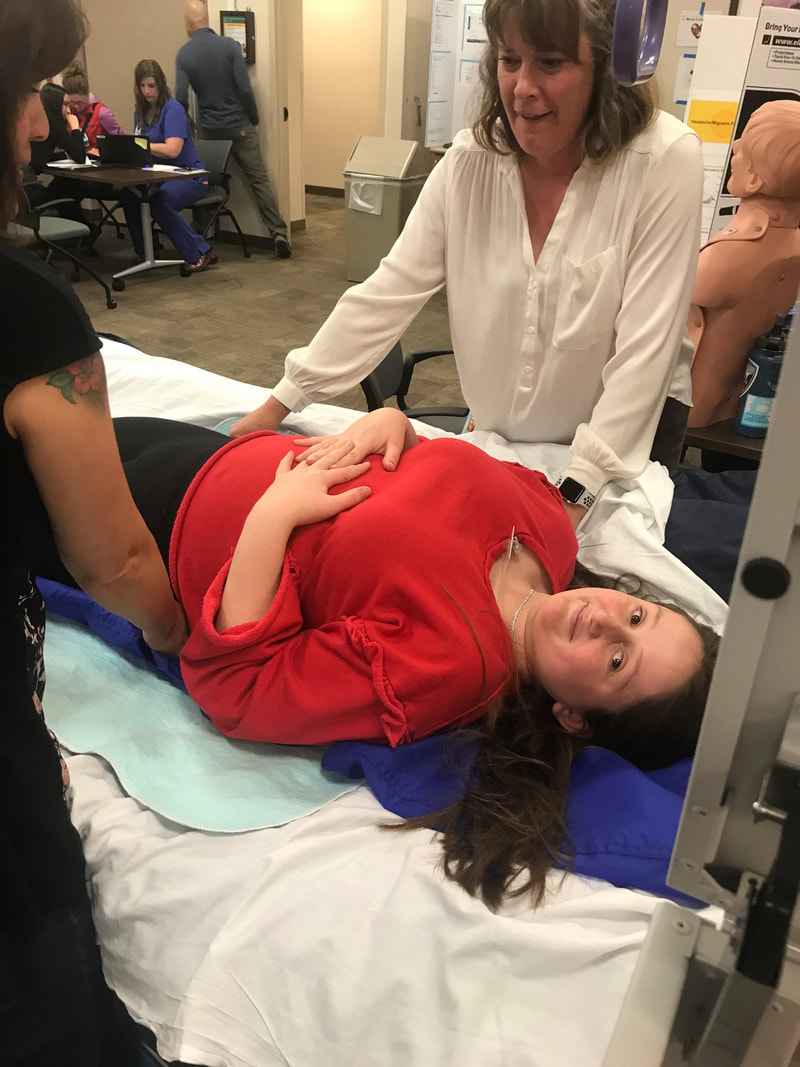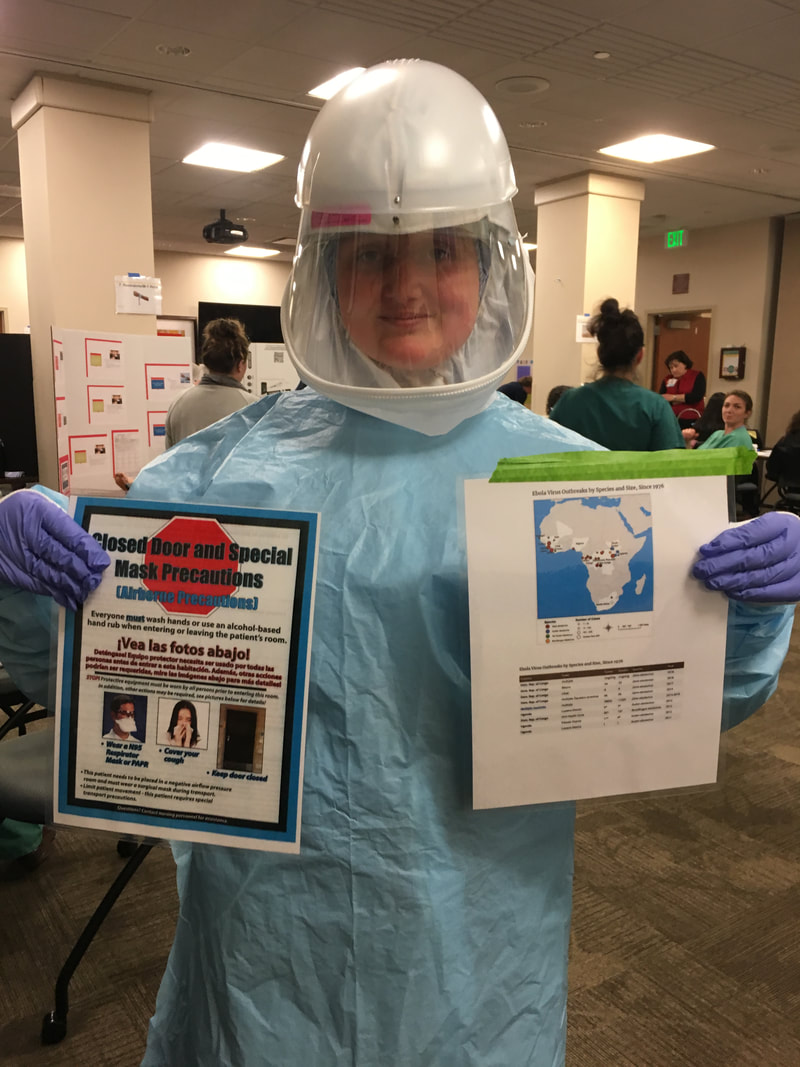What is LINK?
LINK is a 3 week internship that all juniors get to experience at Animas High School. Juniors get the opportunity to follow a professional in a job we might be interested in. We spent about 40 hours a week volunteering our time into something we are passionate about, and even get to skip school for it! LINK supports students in life-long skills such as:
-thriving in a professional setting
-refining college and career goals
-application of what they learn in our classrooms
-making positive contributions to the community
-developing a strong sense of self
-thriving in a professional setting
-refining college and career goals
-application of what they learn in our classrooms
-making positive contributions to the community
-developing a strong sense of self
My LINK
|
Mercy Regional Medical Center is a care hospital that specializes in orthopedic and spine surgery, cardiology, emergency and trauma care, cancer care, and more. It is a non-profit hospital that is part of the Centura Health network.
|
1010 Three Springs Blvd
Durango, Colorado 81301 Phone: (970) 247-4311 https://www.centura.org/locations/mercy-regional-medical-center |
LINK Anticipation
11.5.18
Today I feel unsure where I want to do my internship. I feel like if I do my internship here in Durango it wouldn't be as educational as I want because there isn't much trauma. That's why I want to do my internship in a big city so I can see what it's like being a trauma nurse (which I want my career to be.) The problem with doing my internship in a big city is I don't have that many recourses that I can stay with for 3 weeks. The woman who was going to let me stay in her house is going through a death in the family so we don't know if she will be able to house me.
11.27.18
I might do my internship down in Farmington, my mom is willing to pay for the hotel. I really want a hospital that has a lot of trauma happening. The hard part about this is getting a mentor.
1.26.19
I've decided to stay in town for my internship because everything else fell through. I'm kind of disappointed there won't be a lot of action at this hospital but it's okay because at least I have a plan. All I have to do is talk to Janae about it and get ready to find a mentor.
3.8.19
I have a confirmed mentor but I have no idea what I'm doing at the hospital. I'm hoping I get to be in the ER observing the nurses. Because the process to finding a mentor at Mercy is hard, Janae took over and did it for me. Now I just wait for more information to come in.
LINK Preparation
Setting up my internship wasn't very hard because Janae did most of the work. Janae (my link coordinator) sets up the Mercy Medical Center internships because apparently they are very difficult. All I struggled with the was the anticipation of who my mentor was and what field I will be in! I specifically asked to be in the ER, but am nervous that you have to be of a certain age. We all received an email the night before that told us where to be, what to wear, and bring a lunch. With this great opportunity I will be able to see if nursing is the right fit for me.
LINK Project
With LINK, comes the LINK project. Unfortunately many of the projects done with Mercy Hospital are research papers. I did my research paper in search for more information on Ebola. I chose Ebola because during LINK, I helped with the Skills Fair, a fair that educates nurses on things they might've forgotten in college. For example, sterilization of medical instruments and proper hand washing. I got to actually help the ICU, ER, and Infectious Disease Nurses don and doff for a disease like Ebola. This is when my interest in Ebola came about. Here is my research paper on it.
Ebola Research Paper
So far, at Mercy Regional Medical Center, there has not been one Ebola case. Even though Durango will probably never see an Ebola patient, the hospital assures the ER and ICU staff are ready for whatever comes through the door. On the second week of my LINK Internship, I helped the hospital with their annual Skills Fair. I was assigned to teach sterilization of medical instruments, and how to correctly wash your hands. Fortunately I was able to watch my mentor go through the steps of donning and doffing when seeing an ebola (or any other infectious disease) patient. This is when I became very interested in how ebola came about, how it affects the body, and how to treat it.
Ebola Virus Disease, (also known as EVD), is one of the deadliest viral diseases among humans and animals. Ebola arose in 1976, originating in Central Africa. This deadly disease transferred in humans when a man bought a dead bat to eat. He picked up the bloody bat, that was infected with the Ebola virus, and the blood seeped into a cut in this man's hand. Ebola is spread among humans by sweat, blood, cough, vomit, and other bodily fluids. Because EDV can be spread so easily, hospitals have to be precautious to the point that a trained observer dons and doffs your suit. To keep staff safe from the virus, hospitals have everyone wear 2 layers of gloves (washing gloves every step), a coverall and an outer apron, and a respirator. Below is a picture of me in the Ebola outfit!In the early Ebola outbreaks, around 1976, human to human transmission was the reason the virus spread so quickly. Improper nursing technique was the quickest way the virus would spread, nurses would use 5 syringes a day on 300 to 600 patients. Close contact with infected blood and the reuse of contaminated needles is one way the virus can infect a person.
In 1989, the Ebola virus was discovered in research monkeys imported from the Phillipines to the United States. Scientists later confirmed the virus spread to the monkey population by droplets in the air, (aerosolized transmission) in the facility. Fortunately, an airborne transmission like this does not easily transfer the virus into humans. This discovery of the virus in the monkeys from the Philippines revealed that the Ebola virus was no longer confined in Africa, but had spread to Asia as well. In 1994, the Cote d'ivoire outbreak led the scientists and public health officials to provide the healthcare workers with face masks, gloves, gowns, and disposable equipment. During the 1995 Kikwit, Zaire outbreak the International Public Health Community agreed that it was time to completely contain and control the spread of Ebola in order to end the outbreaks. The local community was educated on how the virus spreads, the hospitals were properly staffed and stocked with necessary equipment. Health Personnel was trained on disease reporting, patient case identification, and methods for reducing transmission in the health care setting.
The most widespread outbreak of Ebola Virus Disease in history began in 2013 and ended in 2016, causing many deaths and socioeconomic disruption in the West African region. The countries that were most affected was Guinea, Liberia, and Sierra Leone. The outbreak caused a significant mortality, with the case fatality rate slightly above 70%. In addition, imported cases led to secondary infection of medical workers in the United States and Spain but did not spread further. The only Ebola cases that were recorded in The United States were due to nurses improperly doffing their uniforms. The United Nations Security Council passed resolution 2177, which stated that the Ebola outbreak was a threat to world peace under article 39 of the UN Charter. This was the first time that the council determined a health issue to be a threat to world peace.
Now, onto the science of ebola. Www.sciencemag.org informs that, “Once the virus enters the body, it targets several types of immune cells that represent the first line of defense against invasion. It infects dendritic cells, which normally display signals of of an infection on their surfaces to activate T lymphocytes, the white blood cells that could destroy other infected cells before the virus replicated further. With defective dendritic cells failing to give the right signal, the T cells don’t respond to infection, and neither do the antibodies that depend on them for activation. The virus can start replicating immediately and very quickly. Ebola, like many viruses, works in part by inhibiting interferon—a type of molecule that cells use to hinder further viral reproduction . Researchers found that one of Ebola’s proteins, called VP24, binds to and blocks a transport protein on the surface of immune cells that plays an important role in the interferon pathway. Curiously, lymphocytes themselves don’t become infected with the virus, but a series of other factors—a lack of stimulation from some cells and toxic signals from others—prevent these primary immune cells from putting up a fight.”
Well, how does Ebola cause hemorrhaging? Www.sciencemag.org informs that, “As the virus travels in the blood to new sites, other immune cells called macrophages eat it up. Once infected, they release proteins that trigger coagulation, forming small clots throughout the blood vessels and reducing blood supply to organs. They also produce other inflammatory signaling proteins and nitric oxide, which damage the lining of blood vessels, causing them to leak. Although this damage is one of the main symptoms of infection, not all patients exhibit external hemorrhaging—bleeding from the eyes, nose, or other orifices.”
1 Baseler L., Chertow D, et. Al. The Pathogenesis of Ebola Virus Disease. Annu. Rev. Pathol. Mech. Dis. 2017. 12:387–418.
2 Goldstein T. et al. The discovery of Bombali virus adds further support for bats as hosts of ebolavirusesExternal. Nature Microbiology. 2018 Aug 27. [Epub ahead of print]
3 Amundsen, S. Historical Analysis of the Ebola Virus: Prospective Implications for Primary Care Nursing Today. Clinical Excellence for Nurse Practitioners. Vol 2. No 6. 1998. 343-351.
4 Baseler L., Chertow D, et. Al. The Pathogenesis of Ebola Virus Disease. Annu. Rev. Pathol. Mech. Dis. 2017. 12:387–418.
5 Amundsen, S. Historical Analysis of the Ebola Virus: Prospective Implications for Primary Care Nursing Today. Clinical Excellence for Nurse Practitioners. Vol 2. No 6. 1998. 343-351.
6 WHO. Health worker Ebola infections in Guinea, Liberia and Sierra Leone: A Preliminary Report 21 May 2015. Accessed June 20, 2017. http://www.who.int/hrh/documents/21may2015_web_final.pdf
7 Khan A. et al. The Reemergence of Ebola Hemorrhagic Fever, Democratic Republic of the Congo, 1995. J Infect Dis(1999) 179 (Suppl 1): S76-86.
8 Baseler L., Chertow D, et. Al. The Pathogenesis of Ebola Virus Disease. Annu. Rev. Pathol. Mech. Dis. 2017. 12:387–418.
The use of contaminated needles and syringes enabled transmission of the virus. Improper nursing technique. Nurses would use 5 syringes a day on 300 to 600 patients.
So far, at Mercy Regional Medical Center, there has not been one Ebola case. Even though Durango will probably never see an Ebola patient, the hospital assures the ER and ICU staff are ready for whatever comes through the door. On the second week of my LINK Internship, I helped the hospital with their annual Skills Fair. I was assigned to teach sterilization of medical instruments, and how to correctly wash your hands. Fortunately I was able to watch my mentor go through the steps of donning and doffing when seeing an ebola (or any other infectious disease) patient. This is when I became very interested in how ebola came about, how it affects the body, and how to treat it.
Ebola Virus Disease, (also known as EVD), is one of the deadliest viral diseases among humans and animals. Ebola arose in 1976, originating in Central Africa. This deadly disease transferred in humans when a man bought a dead bat to eat. He picked up the bloody bat, that was infected with the Ebola virus, and the blood seeped into a cut in this man's hand. Ebola is spread among humans by sweat, blood, cough, vomit, and other bodily fluids. Because EDV can be spread so easily, hospitals have to be precautious to the point that a trained observer dons and doffs your suit. To keep staff safe from the virus, hospitals have everyone wear 2 layers of gloves (washing gloves every step), a coverall and an outer apron, and a respirator. Below is a picture of me in the Ebola outfit!In the early Ebola outbreaks, around 1976, human to human transmission was the reason the virus spread so quickly. Improper nursing technique was the quickest way the virus would spread, nurses would use 5 syringes a day on 300 to 600 patients. Close contact with infected blood and the reuse of contaminated needles is one way the virus can infect a person.
In 1989, the Ebola virus was discovered in research monkeys imported from the Phillipines to the United States. Scientists later confirmed the virus spread to the monkey population by droplets in the air, (aerosolized transmission) in the facility. Fortunately, an airborne transmission like this does not easily transfer the virus into humans. This discovery of the virus in the monkeys from the Philippines revealed that the Ebola virus was no longer confined in Africa, but had spread to Asia as well. In 1994, the Cote d'ivoire outbreak led the scientists and public health officials to provide the healthcare workers with face masks, gloves, gowns, and disposable equipment. During the 1995 Kikwit, Zaire outbreak the International Public Health Community agreed that it was time to completely contain and control the spread of Ebola in order to end the outbreaks. The local community was educated on how the virus spreads, the hospitals were properly staffed and stocked with necessary equipment. Health Personnel was trained on disease reporting, patient case identification, and methods for reducing transmission in the health care setting.
The most widespread outbreak of Ebola Virus Disease in history began in 2013 and ended in 2016, causing many deaths and socioeconomic disruption in the West African region. The countries that were most affected was Guinea, Liberia, and Sierra Leone. The outbreak caused a significant mortality, with the case fatality rate slightly above 70%. In addition, imported cases led to secondary infection of medical workers in the United States and Spain but did not spread further. The only Ebola cases that were recorded in The United States were due to nurses improperly doffing their uniforms. The United Nations Security Council passed resolution 2177, which stated that the Ebola outbreak was a threat to world peace under article 39 of the UN Charter. This was the first time that the council determined a health issue to be a threat to world peace.
Now, onto the science of ebola. Www.sciencemag.org informs that, “Once the virus enters the body, it targets several types of immune cells that represent the first line of defense against invasion. It infects dendritic cells, which normally display signals of of an infection on their surfaces to activate T lymphocytes, the white blood cells that could destroy other infected cells before the virus replicated further. With defective dendritic cells failing to give the right signal, the T cells don’t respond to infection, and neither do the antibodies that depend on them for activation. The virus can start replicating immediately and very quickly. Ebola, like many viruses, works in part by inhibiting interferon—a type of molecule that cells use to hinder further viral reproduction . Researchers found that one of Ebola’s proteins, called VP24, binds to and blocks a transport protein on the surface of immune cells that plays an important role in the interferon pathway. Curiously, lymphocytes themselves don’t become infected with the virus, but a series of other factors—a lack of stimulation from some cells and toxic signals from others—prevent these primary immune cells from putting up a fight.”
Well, how does Ebola cause hemorrhaging? Www.sciencemag.org informs that, “As the virus travels in the blood to new sites, other immune cells called macrophages eat it up. Once infected, they release proteins that trigger coagulation, forming small clots throughout the blood vessels and reducing blood supply to organs. They also produce other inflammatory signaling proteins and nitric oxide, which damage the lining of blood vessels, causing them to leak. Although this damage is one of the main symptoms of infection, not all patients exhibit external hemorrhaging—bleeding from the eyes, nose, or other orifices.”
1 Baseler L., Chertow D, et. Al. The Pathogenesis of Ebola Virus Disease. Annu. Rev. Pathol. Mech. Dis. 2017. 12:387–418.
2 Goldstein T. et al. The discovery of Bombali virus adds further support for bats as hosts of ebolavirusesExternal. Nature Microbiology. 2018 Aug 27. [Epub ahead of print]
3 Amundsen, S. Historical Analysis of the Ebola Virus: Prospective Implications for Primary Care Nursing Today. Clinical Excellence for Nurse Practitioners. Vol 2. No 6. 1998. 343-351.
4 Baseler L., Chertow D, et. Al. The Pathogenesis of Ebola Virus Disease. Annu. Rev. Pathol. Mech. Dis. 2017. 12:387–418.
5 Amundsen, S. Historical Analysis of the Ebola Virus: Prospective Implications for Primary Care Nursing Today. Clinical Excellence for Nurse Practitioners. Vol 2. No 6. 1998. 343-351.
6 WHO. Health worker Ebola infections in Guinea, Liberia and Sierra Leone: A Preliminary Report 21 May 2015. Accessed June 20, 2017. http://www.who.int/hrh/documents/21may2015_web_final.pdf
7 Khan A. et al. The Reemergence of Ebola Hemorrhagic Fever, Democratic Republic of the Congo, 1995. J Infect Dis(1999) 179 (Suppl 1): S76-86.
8 Baseler L., Chertow D, et. Al. The Pathogenesis of Ebola Virus Disease. Annu. Rev. Pathol. Mech. Dis. 2017. 12:387–418.
The use of contaminated needles and syringes enabled transmission of the virus. Improper nursing technique. Nurses would use 5 syringes a day on 300 to 600 patients.
LINK Reflection
` LINK is a 3 week internship that all juniors get to experience their junior year at Animas High School. For my link, I was able to follow nurses around in a clinic at Mercy Medical Center (website: https://www.centura.org/locations/mercy-regional-medical-center). In order to get this internship, I was assisted by the link coordinator, Janae Hunderman. Unlike many other internships, mine did not require me to meet my mentor or even email my mentor, all the information and paperwork was handled through Janae and my mentor, Jennifer. I struggled with this way of communicating because I wasn’t really sure what I was supposed to do. Every few weeks Janae would tell me what’s happening, but I never really got the full story. Because I didn’t have a one on one conversation with my mentor before my internship, I felt like I didn’t really ever meet my mentor, I just had a bunch of people I followed around while they did their jobs. I didn’t get the information on where I was supposed to be on the first day of internship until the night before, which was a struggle. I chose this opportunity to intern at the hospital because I aspire to be an ER Nurse. From this experience I wanted to gain knowledge on what an ER Nurses shift looks like throughout the day, and what they deal with. I wanted to help the hospital with any help they needed, for example interning at the Skills Fair. The mark I left at the hospital was the things I taught all the nurses, sterilization and hand washing.
For my link, I followed nurses and MA’s while they did their jobs in the clinics. I visited the Cardiology Clinic, the Neurology Clinic, and the Oncology Clinic. One day I also got to be at the Cath lab, one day I got to watch a C Section, and one day I got to watch a epidural and a vaginal birth. The skill I had coming into link was how to take most of the basic vital signs. I knew how to correctly take a pulse/ox, listen to the heart, and take blood pressure. The nurses let me take a lot of the patient's pulse/ox which was awesome. I also got to take a mans blood pressure right before he had a heart procedure.
The skills and abilities I came in with during link was active listening. I’m not much of a talker, so listening is what I’m pretty good at. Listening in the medical field is very important because everything the patient is telling you is crucial. Another skill that was useful for me was being observant, I would make sure I knew my way around the clinic I was working in, and making sure I was observing the things the nurses would do. A skill I obtained during LINK was being communicative with a patient. At first as I was in the clinics I would not talk to the patients, just be standing there awkwardly in the patient room listening to what they're talking about. They would usually be talking about new medications and updating their health status. But as I soon realized patients liked when everyone would smile and be welcoming. A lot of the patients I saw were in critical condition so seeing happy faces around them would have made them more comfortable. I found that making small talk with a patient, saying how was your day, how are you doing this morning, was beneficial because it didn’t feel like some weird stranger was listening to their private information.
The challenge I struggled with was that I wasn’t able to work in the field I want to, the Emergency Room. Unfortunately you have to be graduated from highschool to work in the Emergency Room, Operating Room, and the ICU. Because I couldn’t follow a nurse in the Emergency Room I don’t think I got the full experience I could've during these 3 weeks. I wish I could’ve been more in the birthing center because that’s where I saw the most blood and needles. Unfortunately I was stuck in the boring clinics with patients all day. I think it was still beneficial because now I know for sure that I do not want to be a clinical nurse.
It is important for high school students to have this opportunity because it can change their whole life for the better. Someone can get an internship they think they will love, but come out realizing that they don’t love it, in fact they hate it. This can save a lot of money and time if a person knows they don’t want to study something in college. This is why internships are so important for high school students. This internship has helped me prepare for college because now I have a certain field I want to go into, not a broad range. I know for sure I don’t want to be a clinical nurse which is important. I’m ready to go to college with a certain career in mind which is the most important thing that came out of this internship.
For my link, I followed nurses and MA’s while they did their jobs in the clinics. I visited the Cardiology Clinic, the Neurology Clinic, and the Oncology Clinic. One day I also got to be at the Cath lab, one day I got to watch a C Section, and one day I got to watch a epidural and a vaginal birth. The skill I had coming into link was how to take most of the basic vital signs. I knew how to correctly take a pulse/ox, listen to the heart, and take blood pressure. The nurses let me take a lot of the patient's pulse/ox which was awesome. I also got to take a mans blood pressure right before he had a heart procedure.
The skills and abilities I came in with during link was active listening. I’m not much of a talker, so listening is what I’m pretty good at. Listening in the medical field is very important because everything the patient is telling you is crucial. Another skill that was useful for me was being observant, I would make sure I knew my way around the clinic I was working in, and making sure I was observing the things the nurses would do. A skill I obtained during LINK was being communicative with a patient. At first as I was in the clinics I would not talk to the patients, just be standing there awkwardly in the patient room listening to what they're talking about. They would usually be talking about new medications and updating their health status. But as I soon realized patients liked when everyone would smile and be welcoming. A lot of the patients I saw were in critical condition so seeing happy faces around them would have made them more comfortable. I found that making small talk with a patient, saying how was your day, how are you doing this morning, was beneficial because it didn’t feel like some weird stranger was listening to their private information.
The challenge I struggled with was that I wasn’t able to work in the field I want to, the Emergency Room. Unfortunately you have to be graduated from highschool to work in the Emergency Room, Operating Room, and the ICU. Because I couldn’t follow a nurse in the Emergency Room I don’t think I got the full experience I could've during these 3 weeks. I wish I could’ve been more in the birthing center because that’s where I saw the most blood and needles. Unfortunately I was stuck in the boring clinics with patients all day. I think it was still beneficial because now I know for sure that I do not want to be a clinical nurse.
It is important for high school students to have this opportunity because it can change their whole life for the better. Someone can get an internship they think they will love, but come out realizing that they don’t love it, in fact they hate it. This can save a lot of money and time if a person knows they don’t want to study something in college. This is why internships are so important for high school students. This internship has helped me prepare for college because now I have a certain field I want to go into, not a broad range. I know for sure I don’t want to be a clinical nurse which is important. I’m ready to go to college with a certain career in mind which is the most important thing that came out of this internship.
PHOTOSSS
Your browser does not support viewing this document. Click here to download the document.
